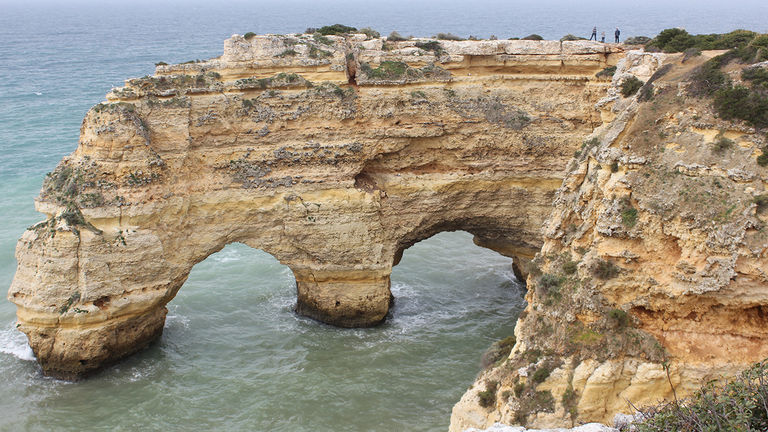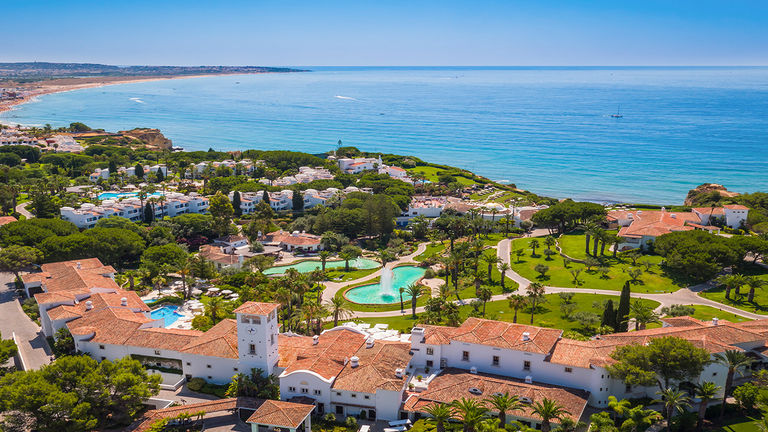The Algarve attracts visitors with its soaring cliffs, secluded beaches, paradisiacal conditions for surfers and culinary delights. In 2022, some 4.8 million visitors headed to this region in southern Portugal; most of them were domestic travelers, more than 1 million were from the U.K. and some 141,000 were from the U.S.
So, what’s the Algarve’s big draw?
To start, the climate in this region is mild and sunny year-round, with more than 3,000 hours of annual sunshine. Whether your clients are looking for adventure, nature or relaxation, there are plenty of things to do here. During my visit, I checked out a number of tourism offerings and, all the while, I found myself noticeably slowing down.
Here’s where to propose your clients eat, sleep and play in Portugal’s Algarve region.
 Praia da Marinha is a beloved beach in the region.
Praia da Marinha is a beloved beach in the region.
Credit: Wibke CarterWhat to Do in the Algarve
One thing is certain: Sunblock and good shoes are must-pack items, as beaches and nature are calling in the Algarve. The rocky coastline is the highlight of the area; I walked the Seven Hanging Valleys Trail, set atop seaside cliffs adorned with stunning shades of ochre and yellow. It passes Praia da Marinha, widely considered one of the most beautiful beaches in Europe.
As most of the shoreline is not accessible on foot, renting a kayak from an operator such as Secret Algarve is a popular option for further exploration. Alternatively, tours that enter the famous Benagil Sea Cave by boat are on offer from companies such as Tridente Boat Trips.
Cristina Nugas from Portugal No Limits, meanwhile, takes small groups on customized tours into Ria Formosa Natural Park. We spent a few hours hunting for razor clams and had fresh oysters right on the boat with some sparkling wine. Clients can also explore this diverse ecosystem on day trips, traveling by ferry to the Ria Formosa Islands, including car-free Culatra which is home to a fishing community that lives here year-round.
For arts and culture, the Algarve has some picturesque historic towns. Silves boasts one of the best-preserved Moorish castles in the country and a 13th-century gothic cathedral. Tavira, called “the Venice of the Algarve," charms with cobblestone streets, bougainvillea-lined balconies and more than 30 churches. Lastly, Albufeira, the region’s biggest town, is the place to be for golfing holidays and nightlife.
 The Algarve is home to fine-dining options, including the two Michelin-star Ocean Restaurant.
The Algarve is home to fine-dining options, including the two Michelin-star Ocean Restaurant.
Credit: 2024 Stils PortugalWhere to Eat in the Algarve
With the Atlantic Ocean on your doorstep, fish and seafood are the main players on the menu — but the supporting cast is no less tasty. The region has six Michelin-star restaurants, including the two Michelin-star Ocean Restaurant, which I highly recommend.
“When I came to Portugal 16 years ago, there were only a handful of Michelin-star restaurants; now, there are more than 30,” said Hans Neuner, head chef at Ocean Restaurant. “The Portuguese fine-dining scene has really come into its own.”
At the two Michelin-star Vila Joya, Dieter Koschina serves a new menu every day — unique in the world of fine dining. Then, there’s one Michelin-star CheckIn, set in a former cereal and wine storehouse in Faro, offering just 26 seats and regional specialties in an intimate setting. A Ver Tavira, meanwhile, is a one Michelin-star eatery set right by the castle walls of Tavira town providing spectacular views.
These elevated culinary experiences are often rooted in simple peasant food, which can also be enjoyed in many local taverns and fish restaurants. I stumbled upon Vai e Volta in Olhao (only open for lunch from 12 to 3 p.m.), where all-you-can-eat barbecue fish is just $16 per person.
 Vila Vita Parc Resort and Spa is one accommodation option in the Algarve.
Vila Vita Parc Resort and Spa is one accommodation option in the Algarve.
Credit: 2024 Vila Vita Parc Resort and SpaWhere to Stay in the Algarve
The region has a variety of accommodation options, but beach towns are packed with vacationers in July and especially in August — which means that during this time, it can be challenging to find a room for clients, and prices are at a premium.
Martinhal Sagres Beach Family Resort was a trailblazer in the family luxury hotel sector when it opened more than a decade ago, and is still a great option for groups. 540-acre private estate Praia do Canal Nature Retreat sits in an unbeatable location on the wild coastline, which guests can overlook while basking in the large infinity pool. City slickers will enjoy 3HB Faro, the first five-star hotel in the Algarve’s capital. Its main draw is a chic rooftop pool with views of the city's cobblestone streets and beyond.
I spent three comfortable nights at Vila Vita Parc Resort and Spa, a sprawling resort where American travelers are the No. 1 clientele, according to Rita do Brito Goncalves, PR and communications manager for the property. It boasts expansive sea views, convenient beach access, a top-notch spa and activities from golf to water skiing.
Getting There
Most nonstop services from the U.S. to Portugal will land in Lisbon at Humberto Delgado Airport. The Algarve is served by two airports: The main hub is Faro, but there is also a much smaller domestic airport in Portimao. Local flights between Lisbon and Faro are operated by Tap Air Portugal three to four times per day and take around 50 minutes. Traveling by rental car takes around 2.5 to three hours. Alternatively, clients can catch a train from national operator Comboios de Portugal, which runs between Lisbon and Faro and offers several stops in the Algarve.